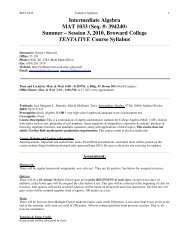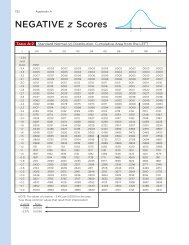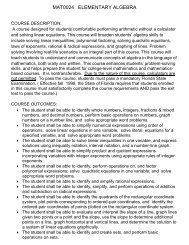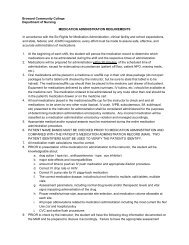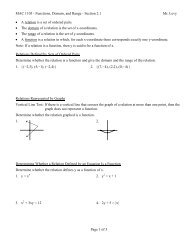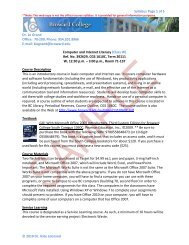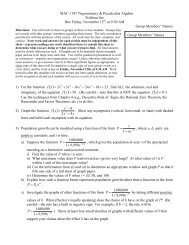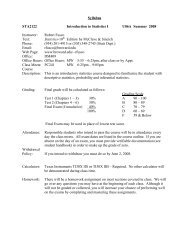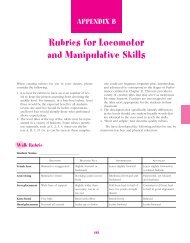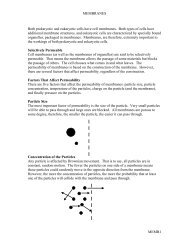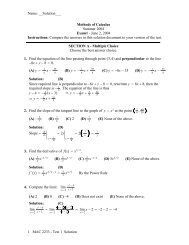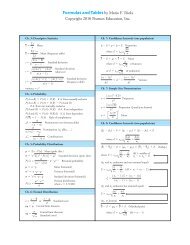Vital Signs Assessment of Vital Signs Temperature
Vital Signs Assessment of Vital Signs Temperature
Vital Signs Assessment of Vital Signs Temperature
- No tags were found...
You also want an ePaper? Increase the reach of your titles
YUMPU automatically turns print PDFs into web optimized ePapers that Google loves.
1/20/2011<strong>Vital</strong> <strong>Signs</strong><strong>Assessment</strong> <strong>of</strong> <strong>Vital</strong> <strong>Signs</strong>• <strong>Temperature</strong>• Pulse• Respirations• Blood Pressure• The fifth vital sign• Pain• Oxygen Saturation<strong>Temperature</strong>• Regulation• hypothalamus• Core body temperaturet• Set point1
1/20/2011Heat Production• Metabolism• Shivering• ExerciseHeat Loss• Radiation• transfer from surface• Conduction• transfer throughdirect contact• Convection• transfer by airmovement• Evaporation• transfer when liquidchanged to a gasOral <strong>Temperature</strong>• 97 - 100 F (98.6)• 36 - 39 C (37)• must be able toclose mouth• eating or smoking,wait• Contraindications• unconscious• seizures• infants, youngchildren• oral disease/surgery• mouth breathing• oxygen by mask2
1/20/2011Rectal <strong>Temperature</strong>• Reliable• Contraindications• Higher than oral by• rectal surgery1o • diarrhea• rectal disease• heart diseaseOther Methods• Axillary• used when oral or rectal contraindicated• lower than oral by 1 o• Tympanic membrane• readily accessible• not affected by eating, smoking, cerumenElevated <strong>Temperature</strong>• Pyrexia• Hyperpyrexia3
1/20/2011Chill Phase• <strong>Signs</strong> andSymptoms• shivering• blood vesselsconstrict• absence <strong>of</strong> sweating• Care• assessment• blankets• fluids• nourishment• OxygenFever Phase• Temp at new setpoint• <strong>Signs</strong> andSymptoms• flushed skin• warm skin• weak, muscle aches• drowsy, restless• Care• Comfort• Hydration• Prevent shivering• Limit physical activity• Oral hygiene• Environmentaltemperature controlFlush or Crisis Phase• <strong>Signs</strong> andSymptoms• pr<strong>of</strong>use diaphoresis• less shivering• flushed, warm skin• Care• fluids• light clothing• hypothermia blanket• Medications• Oral hygiene• Environmentaltemperature control4
1/20/2011Subnormal <strong>Temperature</strong>• Hypothermia• Chemical reactions slowed• Metabolic demands for oxygendecreasedAssessing <strong>Temperature</strong>• Glass thermometers• oral = blue, thin bulb• rectal = red, blunt tip• Electronic• oral = blue• rectal = red• <strong>Temperature</strong> sensitive patches5
1/20/2011Pulse• Rate• pulsations per minute• Infant normal = 80 - 180 per minute• Adult normal = 60 - 100 per minute• Slow < 60, bradycardia• Fast > 100, tachycardia• Slowest at rest, early morningTachycardia• pain• stress• fear• anger• anxiety• exercise• decrease BP• temp• low oxygen• medicationsPulse Rhythm• Pattern <strong>of</strong> pulsations• Regular• Irregular• dysrhythmia• arrhythmia6
1/20/2011Pulse Quality or Amplitude• Description <strong>of</strong> fullness <strong>of</strong> pulse• Ratings• 0 = Absent• +1 = thready, weak• +2 = normal• +3 = bounding<strong>Assessment</strong> Sites• carotid• brachial• radial• femoral• popliteal• posterior tibial• dorsal pedis• apical• 5th ICS left• use stethoscope7
1/20/2011Apical - Radial Pulse• 2 nurses• count at same time• differences found with irregular pulsesRespiration• Movement <strong>of</strong> air in and out <strong>of</strong> lungs• Regulation• carbon dioxide levels• oxygen levels• Normal adult rate: 12 to 20 per minute• Infant rate 30 - 80 per minuteDeviations From Normal• rate:• illness, fever• acute pain• stress• exercise• altitude• body position• rate• narcotics• CNS depressants8
1/20/2011Respiratory Terms• Apnea• Dyspnea• Orthopnea• Tachypnea• Bradypnea• Cheyne - StokesBlood Pressure• Force <strong>of</strong> blood against vessel walls• Systolic pressure• Diastolic pressure• Pulse pressureFactors to Maintain BP• Peripheral Resistance• Pumping action <strong>of</strong> the heart• Blood volume• Viscosity <strong>of</strong> the blood• Elasticity <strong>of</strong> vessel walls9
1/20/2011Factors Affecting BP• Age• Time <strong>of</strong> day• Gender• Eating• Exercise• Emotions• Position• Activity• Smoking/drinkingClassification <strong>of</strong> BloodPressure for AdultsBlood Pressure SBP DBPClassification mmHg mmHgNormal 100Source: The Seventh Report <strong>of</strong> the National committee on Prevention, Detection, Evaluation, and Treatment <strong>of</strong> High BloodPressure, US Department <strong>of</strong> Health and Human Services, National Institutes <strong>of</strong> Health. 2004.Hypotension• Usually considered less than 90 systolic• The patient’s tolerance is significant indetermining the diagnosis• Orthostatic or postural hypotension10
1/20/2011Proper Measurement• Correct position• arm at heart level• Arm above heart level - low reading• Arm below heart level - high reading• Korotk<strong>of</strong>f Sounds• first sound = systolic• absence <strong>of</strong> sounds = diastolic• Auscultatory gapProper Measurement• Cuff Size• too large - low reading• too small - high reading• Bladder width 40% <strong>of</strong> limb circumference• Bladder length 80% <strong>of</strong> limb circumference11



